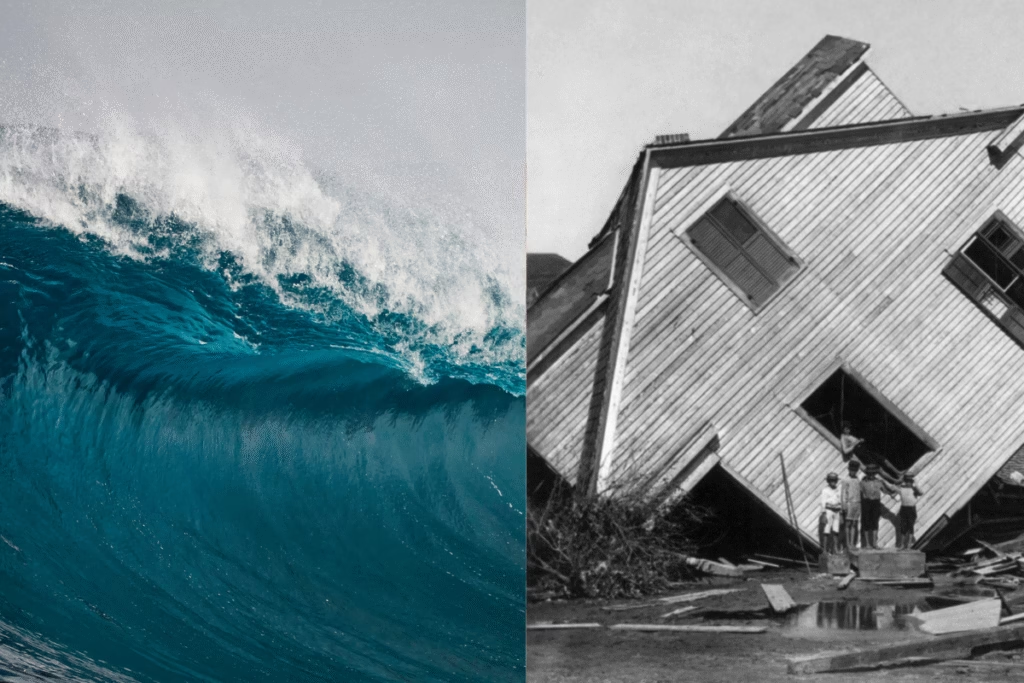Top 10 Deadliest Tsunamis in History : Nature’s Fury and Humanity’s Resilience
Top 10 Deadliest Tsunamis in History : Tsunamis, often triggered by powerful undersea earthquakes, volcanic eruptions, or landslides, are among nature’s most formidable forces. Unlike typical ocean waves, tsunamis are characterized by immense wavelengths and the sheer volume of water they carry. In the deep ocean, they can travel at the speed of a jet plane, almost unnoticed. However, as they approach shallower coastal areas, their speed decreases dramatically, and their height surges, transforming them into towering walls of water that can engulf vast stretches of land.
The human toll of these events is staggering. Since 1850 alone, tsunamis have claimed over 430,000 lives. Drowning is the most common cause of death, but the dangers extend far beyond the initial surge. Collapsing buildings, electrocution from damaged power lines, explosions from ruptured gas tanks, and the impact of tons of floating debris contribute to the tragic loss of life.

Here are 10 of the deadliest tsunamis in history, each a testament to nature’s raw force and the resilience of those who survived or were lost:
- 2004 Indian Ocean Tsunami (Sumatra, Indonesia)
- On Boxing Day, December 26, 2004, the world watched in horror as a colossal undersea earthquake unleashed a series of waves that swept across the Indian Ocean. From the bustling beaches of Thailand to the serene coastlines of Sri Lanka and India, life was irrevocably changed in an instant. Over 230,000 lives were extinguished, many of them tourists enjoying holiday festivities, local fishermen, and families by the sea. The sheer scale of the devastation, the countless missing, and the heart-wrenching stories of survival and loss resonated globally, leading to unprecedented humanitarian efforts and a re-evaluation of early warning systems.
- 1755 Lisbon Earthquake and Tsunami (Portugal)
- On All Saints’ Day, November 1, 1755, devout citizens of Lisbon were in church when a powerful earthquake struck. As survivors rushed to the waterfront for safety, they were met by towering tsunami waves that engulfed the city’s harbor and downtown. The triple tragedy of earthquake, fire, and tsunami obliterated a vibrant capital, leaving an estimated 50,000 to 100,000 dead and forever altering the city’s spirit and urban planning. It profoundly impacted European philosophy and the understanding of natural disasters.
- 1883 Krakatoa Tsunami (Indonesia)
- The cataclysmic eruption of the Krakatoa volcano in August 1883 was so immense, its sound was heard thousands of miles away. But it was the colossal tsunami waves, some reaching over 37 meters (120 feet) high, that truly brought devastation. They crashed down on coastal towns and villages in Java and Sumatra, wiping them off the map. Over 34,000 people perished, many caught unaware by the volcano’s watery aftermath. The lingering ash cloud affected global temperatures for years, a sombre reminder of the interconnectedness of Earth’s forces.
- 1498 Enshunada Sea Tsunami (Japan)
- History’s whispers tell of a powerful earthquake off the coast of Japan in 1498 that triggered a devastating tsunami. Waves, reportedly 56 feet high, slammed into the coast of Meio Nankai, sweeping away an estimated 31,000 lives. It was a tragedy that reshaped coastal communities, forcing them to rebuild and adapt to the ever-present threat from the sea.
- 1896 Sanriku Tsunami (Japan)
- On June 15, 1896, residents along Japan’s Sanriku coast were celebrating a holiday when a relatively distant earthquake struck. Many felt the tremor but didn’t realize the silent danger approaching. Less than 30 minutes later, waves as high as 38 meters (125 feet) crashed ashore, annihilating countless fishing villages and claiming around 27,000 lives. The sheer unexpectedness and the colossal height of the waves made this a particularly horrifying event, leaving deep scars on the collective memory of the region.
- 1868 Arica Tsunami (Peru and Chile)
- An 8.5-magnitude earthquake off the southern coast of Peru on August 13, 1868, turned the city of Arica (now in Chile) into rubble. What followed was even more tragic: a massive trans-Pacific tsunami, with waves reaching up to 27 meters (90 feet), that swallowed the harbor, destroyed buildings, and ultimately claimed an estimated 25,000 lives along the coasts of Peru and Chile. Its reach extended across the Pacific, even causing damage in Hawaii.
- 2011 Tōhoku Tsunami (Japan)
- On March 11, 2011, Japan, a nation renowned for its earthquake preparedness, faced an unimaginable challenge. A magnitude 9.0 earthquake off its northeastern coast unleashed a tsunami that defied expectations. Waves, some over 40 meters (130 feet) high, surged inland, obliterating towns, ports, and critical infrastructure. While the initial death toll was lower than some historical events due to advanced warnings and resilient infrastructure, over 18,000 people still lost their lives, and the ensuing Fukushima Daiichi nuclear disaster added a new layer of complexity to the human cost, displacing hundreds of thousands and leaving a legacy of contaminated land.
- 1792 Unzen Tsunami (Japan)
- The collapse of the flank of Mount Unzen in Japan in 1792, triggered by volcanic activity, sent a massive landslide into Shimabara Bay. This created a giant tsunami, known as the “Shimabara Catastrophe,” that swept across the bay, hitting the opposing Higo province. The double disaster of volcanic eruption and tsunami resulted in an estimated 14,524 deaths, a testament to the combined destructive power of geological forces.
- 1771 Ryukyu Islands Tsunami (Japan)
- An earthquake off the coast of the Ryukyu Islands in Japan on April 24, 1771, generated a series of powerful tsunami waves. While estimates of wave height vary, they were significant enough to destroy over 3,000 homes and claim nearly 12,000 lives across the islands. The isolation of these islands likely compounded the tragedy, as help would have been slow to arrive.
- 1586 Ise Bay Tsunami (Japan)
- On January 18, 1586, an estimated magnitude 8.2 earthquake struck, generating tsunami waves that rose to a height of 6 meters (20 feet) in Ise Bay, Japan. While the exact death toll is uncertain, historical accounts indicate significant loss of life, with estimates around 8,000. This event, like many early tsunamis, highlights the vulnerability of coastal populations before modern warning systems and understanding of these natural phenomena.
ALSO READ : Tsunami Warning: The Pacific Awakens After 8.8 Earthquake
The Unseen Waves: When the Ocean Strikes
The immediate aftermath of a tsunami is chaos. Survivors often grapple with severe injuries, crush wounds, fractures, and widespread contamination of drinking water, leading to the potential spread of diseases like cholera and malaria. The psychological toll is immense, with many survivors experiencing post-traumatic stress disorder (PTSD), grief, and long-term trauma due to the loss of family, homes, and livelihoods.
But the impact extends far beyond the immediate human suffering:
- Infrastructure Devastation: Homes, businesses, roads, bridges, ports, and communication networks are obliterated. The sheer force of the water can sweep away entire towns, leaving behind only foundations and vast fields of debris. Rebuilding this infrastructure is a monumental and costly task that can take years, even decades.
- Economic Ruin: Coastal communities, heavily reliant on fishing, tourism, and maritime trade, face complete economic collapse. Livelihoods are destroyed, businesses are shuttered, and the long road to recovery is fraught with financial challenges. The cost of reconstruction can amount to billions of dollars, significantly burdening national economies.
- Environmental Catastrophe: Tsunamis leave a lasting scar on the environment. Saltwater inundation contaminates fresh water supplies and renders agricultural land infertile for years due to salination and debris. Fragile ecosystems like coral reefs, mangrove forests, and wetlands are extensively damaged or destroyed, impacting biodiversity and natural protective barriers against future disasters. The massive amount of debris generated also poses a significant environmental challenge, with proper disposal often difficult.
Echoes of Devastation: Stories from the Survivors and Lost
Beyond the numbers, each tsunami represents a tapestry of human stories. The chilling accounts of those who witnessed the ocean recede unnaturally before the wave struck, the desperate scramble for higher ground, the heart-wrenching search for loved ones, and the quiet resilience of communities starting anew from rubble. For example, in the aftermath of the 2004 Indian Ocean Tsunami, stories emerged of incredible courage and acts of selflessness, as well as the profound grief of families who lost everything. The societal recovery is a complex process, often involving not just physical rebuilding but also the psychological healing of individuals and the re-establishment of community bonds. Aid organizations and governments play crucial roles, but true recovery is often driven by the ingenuity and determination of the affected communities themselves, sometimes leading to a “build back better” approach, incorporating more resilient structures and improved warning systems.
Learning from the Past: Building a Safer Future
The lessons learned from these devastating events have spurred significant advancements in disaster preparedness and mitigation. Early warning systems, utilizing seismic sensors and ocean buoys, are now more sophisticated, providing precious minutes or hours for evacuation. Public awareness campaigns educate coastal populations about the natural signs of a tsunami, such as a sudden drawback of the sea, and emphasize the importance of immediate evacuation to higher ground.
Furthermore, efforts are underway to build more tsunami-resilient infrastructure, including stronger building codes, the construction of seawalls and breakwaters, and even the strategic planting of natural barriers like mangroves, which can help absorb wave energy. However, continuous vigilance, investment in research, and international cooperation remain vital to protect vulnerable coastal communities from the silent, relentless power of these natural phenomena.
While we cannot prevent tsunamis, by understanding their destructive power and incorporating the lessons of the past, we can strive to minimize their human toll and build a more resilient future for those who live on the ocean’s edge.
What more would you like to know about the impact and recovery from tsunamis?

